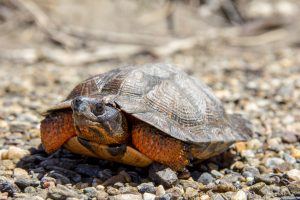
20 Jan AN INVESTMENT OF MORE THAN 1M$ TO SUPPORT THE CONSERVATION OF SPECIES AT RISK

Monarch butterfly (Adobestock).
STRENGTH IN UNITY:
APPALACHIAN CORRIDOR AND SEVEN REGIONAL ORGANIZATIONS
COMMIT TO IMPROVING THE CONSERVATION OF SPECIES AT RISK
THANKS TO A MORE THAN 1M$ INVESTMENT
Eastman, Quebec (January 20, 2021) – Following the Government of Canada’s announcement of a 1.07-million-dollar investment over four years for the conservation of species at risk in the Northern Green Mountains of southern Quebec, Appalachian Corridor is happy to announce the establishment of an innovative collaboration group intent on advancing conservation efforts in the region.
“The Northern Green Mountains region supports a wealth of biodiversity and is home to 42 species at risk, including the monarch butterfly,” shares Lyne Bessette, Member of Parliament for Brome–Missisquoi, Quebec. “Conserving this environment ensures the survival of these species and helps fight climate change. The fieldwork carried out by Appalachian Corridor and its partners is essential. More than ever, protecting the environment is at the heart of our priorities. By working with local organizations, we can achieve Canada’s goal of protecting a quarter of our land and a quarter of our oceans by 2025.”
Adjacent to the Canada-US border, the natural region of the Northern Green Mountains includes large, wooded areas and distinguishes itself with a particularly high concentration of lakes in the Appalachians as well as several humid environments. The vast region of southern Quebec is home to close to two-thirds of all species inventoried as part of the Quebec biodiversity.

Butternut (Juglans cinerea) (Corridor appalachien).
The main threats to critical habitat of the species concerned in the Northern Green Mountains natural area are the destruction, fragmentation, and degradation of natural environments; the increase of recreational activities; the expansion of the road network; the overexploitation of resources; the increased presence of invasive alien species and certain problematic native species; agricultural activities; and climate change.
In order to increase the positive outcomes from the funding for species at risk, Appalachian Corridor has created a unique regional working group, comprised of environmental organizations covering broad horizons: Réseau de milieux naturels protégés, Conseil de gouvernance de l’eau des bassins versants de la rivière Saint-François, Organisme de bassin versant de la Yamaska, Fondation SETHY, QuébecOiseaux, Conservation de la Nature Canada and the Granby Zoo.
 Wood turtle (Marc Lepage).
Wood turtle (Marc Lepage).
For the coming years, these organizations will work in concert to maximize the impact of the Government of Canada’s funding by focusing their efforts on five core themes. These are: the increase of collaboration between all partners to stimulate the sharing of best practices in the realm of conservation; the realization of concerted follow-ups regarding certain species at risk; the protection of key conservation natural areas; the added support to municipalities in their efforts to account for ecological corridors and promote connectivity and adaptation to climate change; and the hosting of various educational and awareness-building activities to emphasize the importance of conserving natural areas as a means to support the adaptation to climate changes.
“At the heart of this program lies a particularly unique collaboration,” explains Martine Ruel, partnership and stewardship director at Appalachian Corridor. “All the organizations involved are fueled by a common vision and a relentless drive to do what is best to protect the beauty and health of the precious environment that surrounds us. By unifying our strengths and our commitment, we will be in a better position to generate positive outcomes for the biodiversity and the community. We are very grateful for the Government of Canada’s support to help accelerate these initiatives.”
“The Zoo de Granby is recognized as an important player in the protection of exotic species, such as elephants and gorillas in Cameroon,” tells Patrick Paré, director of conservation and research at the Granby Zoo. “Our biologists are also leading several projects in Quebec on turtles, bats, and aerial insectivorous birds. It is very rewarding to work on the preservation of endangered species with Appalachian Corridor, through this conservation initiative in the Northern Green Mountains, on projects where one really feels the appreciation of the population,” he concludes.
 Small brown bat (Yves Déry).
Small brown bat (Yves Déry).
ABOUT
Canada Nature Fund’s Community-Nominated Priority Places for Species at Risk Initiative
The Canada Nature Fund’s Community-Nominated Priority Places for Species at Risk initiative is a four-year, $15.6 million funding initiative administered by Environment and Climate Change Canada. canada.ca
CONTACT
Marie-Hélène Thibeault
Communications coordinator
Appalachian Corridor
579-488-6670
www.corridorappalachien.ca


